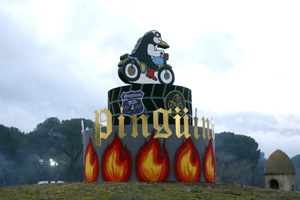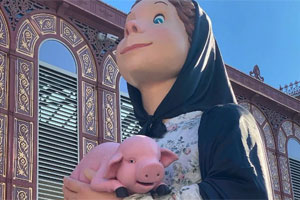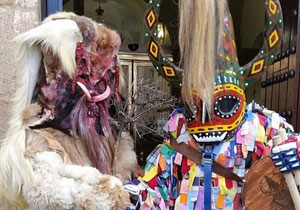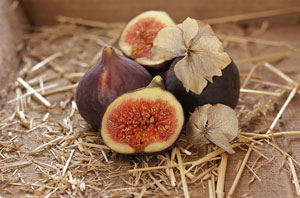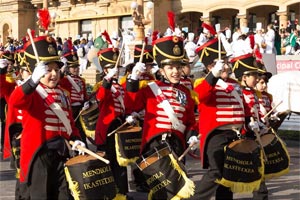Corpus Christi in Camuñas
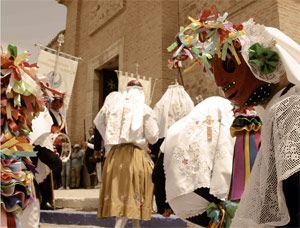
How Corpus Christi is celebrated in Camuñas
In the town of Camuñas, a very special festival takes place that attracts thousands of people every year. This celebration, recognized as a National Tourist Interest Festival and Intangible Cultural Heritage, is distinguished by the participation of two main groups: the "Pecados" (Sins) and the "Danzantes" (Dancers). Each of these groups presents themselves in impressive attire that sets them apart.
The Pecados and Danzantes
The group of Pecados represents evil and is characterized by their rich and opulent costumes. They carry long staffs and wear horrifying masks that reveal their malevolent mission. Their attire is dominated by red and black, symbolizing the sins and flaws of humanity. On the other hand, the Danzantes embody joy and goodness. They dress in white and also wear masks, although theirs have a longer and more pointed shape. They are very cheerful and represent virtues and benevolent souls.
Both groups have a well-defined internal hierarchical structure. During the celebration, the Pecados wait outside while the mass takes place. Once the procession begins, they attack with shouts and screams, accompanied by fireworks, until they are ultimately humiliated. Then, the Danzantes take the spotlight and perform a dance known as "el cordón" to the rhythm of the music.
The different masks and variations in the attire of the Pecados and Danzantes represent various characters. For example, "El Pecado Mayor" wears a pig mask and personifies the devil, while "El Judío Mayor" symbolizes the blindness of faith. Other characters include "El Capitán" (charity), "El Alcalde" (hope), "El Tambor" (temperance), and "La Porra" (fortitude). Additionally, during the procession, "La Madama" traverses the path and gathers the Danzantes, forming a long column behind her. It is important to note that the entire performance is done without words, evoking the sacramental plays and dramatic works of the Golden Age.
The festival involves men of all ages from the town, who can join either of the groups once they have received their first communion. The streets and squares of Camuñas are filled with people eagerly witnessing the procession in which the Pecados and Danzantes participate.
The celebration lasts for four days, starting on Wednesday afternoon and concluding on the following Sunday, also known as the Octave Sunday. The exact date varies each year, depending on the day of Corpus Christi. Additionally, the festival has a dedicated museum, the Interpretation Center of Pecados and Danzantes, which allows visitors to delve into its meaning and traditions.
Details of the Performance
The representation is not limited to just the morning mass; it begins much earlier within each group. They gather in private homes to celebrate and embark on a procession before the mass. During this procession, the parish priest and the town authorities are collected. Once the mass begins, only the Pecados remain outside the church. At the end of the mass, the procession begins.
In the Plaza del Reloj or Ramón y Cajal Square, the Pecados launch an attack against the good, and a shot announces the arrival of La Pecadilla, a figure that appears to be good but whose attire reveals her malevolent mission. Then, the Pecado Mayor enters, whose black dress and pig mask symbolize the devil, accompanied by a spine-chilling howl.
Afterwards, the rest of the Pecados group joins, representing the malignant forces and sins of the world. Following that, El Correa arrives, putting an end to the battle. His red attire emulates the sins of the world, and finally, all the Pecados fall humiliated. The Danzantes then begin to perform a highly significant dance called "Tejer el cordón" (Weaving the cord).
The rows of Danzantes are led by Prudencia (Prudence) on the left and the cordel (cord) representing justice on the right. Other participating characters include El Judío Mayor (The Elder Jew), who represents the blindness of faith in an immobile manner; El Capitán (The Captain), representing charity; El Alcalde (The Mayor), embodying hope; El Tambor (The Drum), symbolizing temperance; and La Porra (The Bludgeon), personifying fortitude. In the center of the formation is La Madama, whose name has a strong French influence. She is a female character with a hairless mask. La Madama traverses the two rows of Danzantes and gathers them behind her, forming a long column closed by charity.
Following that, the procession begins, traversing the streets of the town, mainly in the western area and passing through main streets such as Veracruz, Grande, or Alcázar.

Origin and History
The festival at hand has its roots in the 16th and 17th centuries when dances began adopting the form of Sacramental Autos to pay tribute to the heavenly Lord through rhythm and music. At that time, religious fervor adorned every corner of the celebration.
Over time, the festival has acquired various interpretations, culminating in its current form, representing a mimetic sacramental play that confronts good and evil.
What to see in Camuñas
Camuñas is a town that offers various places of interest to visit. Here are some suggestions on what to see in Camuñas:
- Main Square: The heart of the town is a good starting point. Camuñas' Main Square features a central fountain and is surrounded by historical buildings, such as the Town Hall. It's a pleasant place to stroll and enjoy the atmosphere.
- Parish Church of San Juan Bautista: This 16th-century church is one of the main religious monuments in Camuñas. It stands out for its Renaissance-style facade and its interior decorated with altarpieces and religious artwork.
- Pecados y Danzantes Interpretation Center Museum: This museum is dedicated to Camuñas' emblematic festival, the Pecados y Danzantes. It provides a detailed insight into the history and meaning of this unique celebration, as well as an exhibition of costumes and related objects.
- Windmill Route: Camuñas is located in an area of windmills, and a route can be taken to visit them. These windmills bear witness to the region's agricultural past and offer panoramic views of the surrounding landscape.
- Hermitage of Nuestra Señora de la Muela: On the outskirts of Camuñas, you'll find this hermitage situated in a natural setting. It's a place of devotion and tranquility, surrounded by beautiful landscapes.
- Natural surroundings: Camuñas is located in a rural area, surrounded by fields and natural landscapes. The surroundings of the town offer the opportunity for peaceful walks and enjoying nature.
These are just a few suggestions of what to see in Camuñas. Remember, the best way to discover the charm of this place is to wander through its streets and explore the picturesque corners it offers.
What to eat in Camuñas
The typical gastronomy of Camuñas is based on traditional and flavorful dishes that reflect the culinary richness of the region. Some popular dishes in the area include:
- Pisto Manchego: A stew made with a variety of vegetables such as tomatoes, peppers, zucchini, and onions, all slowly cooked with olive oil.
- Asadillo Manchego: A salad made with roasted red peppers, tomatoes, garlic, and olive oil. It's a fresh and tasty dish that is often served as a side or as a tapa.
- Cordero Manchego: The region of Castilla-La Mancha is known for its excellent lamb. In Camuñas, it is common to find roasted or stewed lamb dishes, highlighting the tender and juicy flavor of the meat.
- Duelos y Quebrantos: A typical dish of Manchegan cuisine that combines fried eggs with chorizo and bacon. It's a hearty and flavorful dish.
- Gachas: A warm and comforting dish made with almorta flour (a type of legume), water, olive oil, and salt. It is usually served as breakfast or dinner.
- Queso Manchego: Manchego cheese is one of the most emblematic products of the region. It is made with sheep's milk and is characterized by its unique flavor and firm texture. It can be enjoyed on its own or as part of a cheese platter.
- Migas: A traditional Spanish dish consisting of fried breadcrumbs with bacon, chorizo, garlic, and peppers. It's a hearty and very flavorful dish.
These are just a few examples of the popular traditional cuisine of Camuñas. Local food stands out for its quality ingredients and for preserving traditional recipes passed down from generation to generation. A visit to Camuñas is a perfect opportunity to taste these dishes and enjoy authentic Manchegan cuisine.

